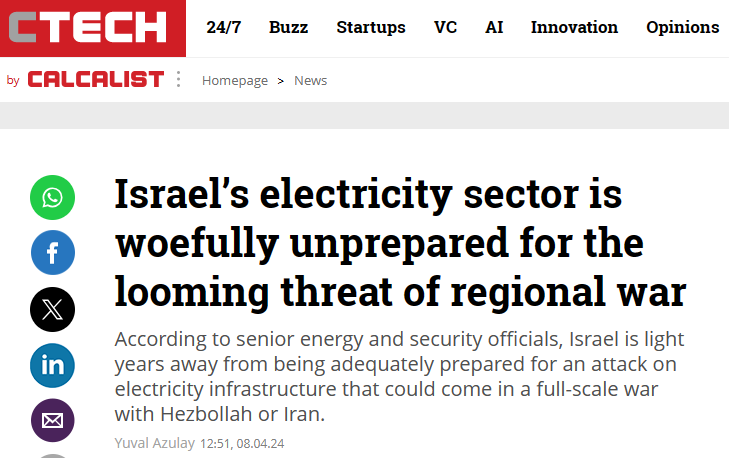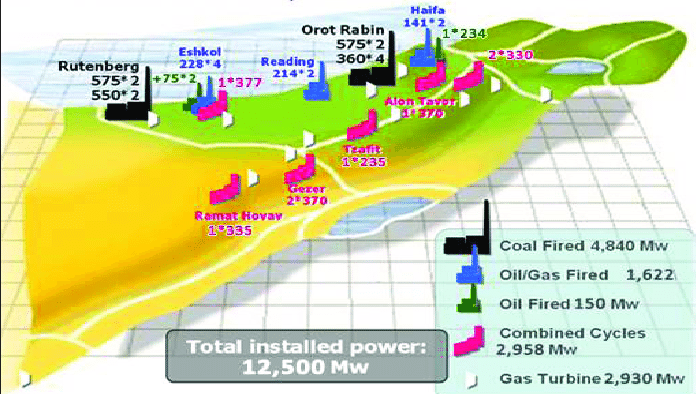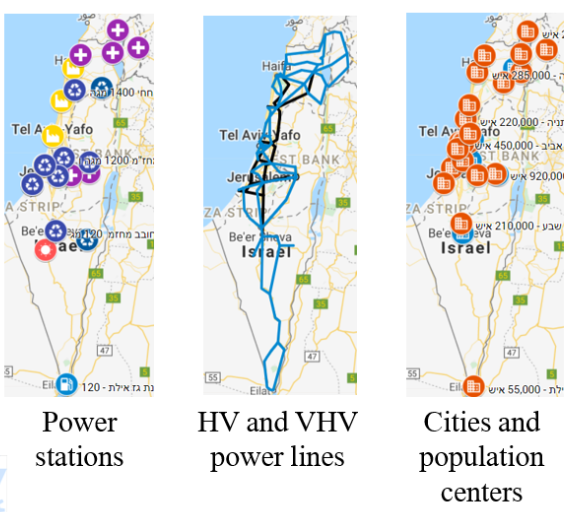Israel has vowed to respond to Iran’s missile attack over the last weekend, despite many reports of US and its allies urging Israel to declare their defense against a very large-scale Iran missile barrage to be a victory. The US and Iran both appear united in wanting to stop further escalation. But Israel has a mind of its own, as demonstrated by its stunning attack on Iran’s embassy grounds in Damascus which initiated this crisis.
It’s possible that Israel could use a cyber attack to retaliate. But that seems unlikely given Israel’s long established policy of making hard hits back in response to assaults. It also seems unlikely given what Alastair Crooke has described as the implicit premise of Israel, that Jews in its borders would be assured of safety. That sense of security took a body blow on October 7. Israelis seem almost driven to re-establish their appearance of military potency.
The next question is whether Israel can be herded or coerced into what would amount to a negotiated attack on Iran, as in hitting targets conveyed to Tehran in advance so it could bolster defenses and get personnel and high-value equipment out of the way. There is still a possibility that Israel could engage in deception, as in communicate it would strike certain locations, then hit different ones.
Another possibility is Israel blowing up Al Aqsa mosque. That would be disproportionate and would set the entire Muslim world on fire. From a recent post at NC by Kevin Kirk:
So the Temple Institute Organization, based in Jerusalem (and supported by Henry Swieca, a wealthy New York financier), who are committed to building the 3rd Temple and restoring animal sacrifice, have swung into action and submitted an application to the Israeli police to use knives to slaughter 5 perfect red heifers as part of a purification ritual elucidated in Numbers Chapter 19 of the Bible. This ceremony, which is taking place on a specially built altar situated on the Mount of Olives opposite the Temple Mount, is set to take place in April 22nd, which is during Passover. Once the purification ceremony has been undertaken then the stage is set for the building of the Temple, leading to the coming of the Messiah and the final battle between good and evil on a hill just outside Haifa called Tel Megiddo, or, as it is called in the Bible: Armageddon.
Some Israelis are already planning their Temple Mount project. Echoes of Israel developers promoting their plans for Gaza post-Palestinians, but with vastly higher stakes:
Settlers in #Israel showing the changes to #AlAqsa Mosque after rebuilding the third temple in it’s place as part of the burning of the Red Heifers. pic.twitter.com/hUJ0DekM5P
— Dylan Griffith (@LivingDadJoke) April 11, 2024
For now, we will limit ourselves to the focus of Western concern, that of a kinetic attack on Iran. A remarkable story at the Financial Times, prominently places as a “Big Read”, Ukraine’s air defence struggle shows risks to Israel, departs radically from Anglosphere practice of heavily propagandized coverage about both the Ukraine and Gaza (and now Iran) conflict. It’s quite the twofer. It not only admits what until recently has been verboten, that Russia has seriously weakened Ukraine’s air defenses and the West can’t do much to shore them back up. It also provides a detailed description of Iran’s barrage and discusses how despite claims of success, they showed Israel vulnerability, particularly to a sustained campaign by Iran. This is not all that different from what you see in the independent media.
So why is the Financial Times making so many admissions against Western interest? It’s not as if these facts are not well known among insiders, particularly the military. My guess is this is an effort to influence Israel loyalists in political circles, particularly the US, as well as private Israel influencers, that escalating with Iran has very high odds of turning out badly for Israel. Nevertheless, it’s surprising to see so much candor while events are still in play.
Key sections:
Israel fended off hundreds of drones and missiles fired by Iran on Saturday using an enviable combination of its own sophisticated air defences and the critical support of western powers and Arab partners.
But Israel may not be able to pull off that performance and sustain crucial outside support forever — especially if the Jewish state launches a major retaliatory strike against Tehran, which would escalate regional tensions in a way that none of Israel’s allies want.
This is a remarkably stark admission, right at the top.
The article does not mention facts presented by Israel critics like Scott Ritter, who has depicted Iran’s weekend attack as “one of the greatest victories of this century.” Those commentators point out that Iran successfully hit all targets, including air defense sites even after advanced notice. As Ritter stated: “….all of Israel was vulnerable to being struck by Iran at any time, and that there was nothing Israel or its allies could do to stop such an attack.”
The Financial Times quickly starts to inject uncomfortable amounts of reality into Israel’s and its backers’ performance:
While only a handful of Iran’s missiles, and none of its cheap diesel-powered drones, made it through Israel’s multi-layered Aerial Defense Array last weekend, Tehran and its proxies are sitting on a bank of missiles and drones estimated to number in the tens of thousands.
In an all-out war, even Israeli military officials admit at least some of these would break through, especially in the face of repeated salvos fired from multiple directions by Iran-armed militants in Lebanon, Yemen, Syria and Iraq.
Such an assault, in other words, would resemble the desperate situation faced by another western ally: Ukraine…
Iran’s attack against Israel last weekend was massive, by any standard. Tehran launched about 170 drones, more than 30 cruise missiles, and some 120 ballistic missiles…
Unlike Russia’s recent attacks on Ukraine, however, nearly all the incoming Iranian missiles and drones were intercepted. That was partly achieved by Israel’s well-stocked and multi-layered air defences, built and paid for largely with US military assistance.
But it was also thanks to substantial help from a US-led coalition, and the fact that the Iranian salvo was telegraphed in advance, allowing ample time to prepare.
Note that the article does not point out that the drones were sacrificial. If they got through, terrific, but having them serve as decoys was useful to get Israel and its supporters to waste fire before the powerful missiles waves arrived.
The story later says:
Israel threw significant resources at repelling the Iranian barrage…
“Israel defended itself under ideal conditions last weekend when it faced a one-time punitive strike,” said Franz-Stefan Gady, an associate fellow at the International Institute for Strategic Studies think-tank in London.
“The real danger for Israel is that its air defences become saturated during a sustained war . . . that is, if it faces a large number of aerial attacks, over very short intervals, which eventually overwhelm every kind of air defence system,” he added. “Even Israel would then sooner or later deplete its stocks [and] it would face similar challenges as Ukraine does now.”
The piece continues with other Israel-unfavorable facts, such as West’s shortage of air defense missiles and the difficulty of solving that any time soon, and competing demands from Ukraine. The story does not mention that this retaliation was Iran’s show, with no meaningful Hezbollah or Axis of Resistance participation. In a hot conflict, they would almost certainly join up, and in a big way.
The pink paper also omits the cost of Israel’s defense, which an Israeli general put at roughly $1.1 to $1.3 billion. Nor does it mention the cost to the US and other participants, which some experts estimate brought the total cost of the response to the $2 billion range.
And there were other types of costs. From Middle East Eye in US push for a ‘Middle East Nato’ failed to emerge during Iran strikes:
Middle East Eye reported on Friday that the Gulf monarchies were shutting down US options to launch strikes against Iran in the event Washington felt the need to retaliate against Tehran’s attack on Israel. Saudi Arabia, the UAE, Oman, and Kuwait all scrutinised their basing agreements with Washington to do the bare minimum that was required and avoid being involved in direct strikes on Iranian targets.
Bilal Saab, a former US Department of Defence official, now at Chatham House, told MEE that the Gulf states’ calibrated actions underscored the limits of the Biden administration’s push for a Middle East Nato.
“When we start seeing authorisations to use Gulf airspace to launch strikes on Iranian targets, then we can start talking about a Middle East Nato. Right now, it’s the exact opposite,” he said.
But but but….what about Israel having the ultimate upper hand with its nukes? There is more here than meets the eye. From Simplicius the Thinker:
…one of the common counterarguments is that Israel possesses nuclear weapons, which ultimately trumps anything Iran can throw at them. But in reality, now that Iran has proven the ability to penetrate Israel, Iran too can cause nuclear devastation by striking the Israeli Dimona nuclear power plant. Destroyed nuclear plants would produce far more radioactive chaos than the relatively ‘clean’ modern nuclear weapons. Furthermore, Israel is much smaller than the comparatively gigantic Iran. Iran can take many nuclear hits and survive; but a single mass nuclear event in Israel could irradiate the entire country, making it uninhabitable.
Finally, John Helmer discusses the possibility of Iran following Russia’s electric war strategy with Israel if the conflict escalates. Helmer’s sources venture that due to lack of Israel preparedness, Iran could inflict a great deal of damage in short order.
By John Helmer, the longest continuously serving foreign correspondent in Russia, and the only western journalist to direct his own bureau independent of single national or commercial ties. Helmer has also been a professor of political science, and an advisor to government heads in Greece, the United States, and Asia. He is the first and only member of a US presidential administration (Jimmy Carter) to establish himself in Russia. Originally published at Dances with Bears
No Russian military source will publicly express the line that Iran’s attack on Israel of April 14 was a strategic success, despite the tactical shortcomings. This is first of all because Iran is a strategic ally of Russia in its war against the US and NATO in the Ukraine, in Syria, and in Yemen.
It is also because of what may happen next. If Israel escalates by attacking Iran and striking at the country’s infrastructure, then Iran’s counter will be to take a page out of Russia’s book and commence the one line of attack which Israel, the US and their allies cannot withstand any better than Ukraine – that’s Electric War.
For the seven months which have elapsed since Hamas began its operation against Israel on October 7, and Israel commenced its genocide against the Palestinians, there has been no targeting by Hamas, Hezbollah, the Houthis, or the Syrian and Iraqi groups of Israel’s highly vulnerable maritime gas platforms, gas pipelines, coal and oil-fired electricity generating plants, the coal and oil storages nearby, solar and wind power units, or the electricity grids keeping the country alight.
The Arab inhibitions and calculations are understandable. Iran’s will disappear if Israel triggers a new round of attacks.
If and when that happens, the Palestinian failure in the US and in Europe to counterattack and stop Israel financing its war through the $60 billion genocide bond issue won’t matter. Bond holders don’t invest in blackouts.
On the published Israeli counts to date, Iran launched between 180 and 185 drones, 30 to 36 cruise missiles, and 110 to 120 ballistic missiles; click to read the calculations reported by the New York Times and the local Israeli media.
The outcome counted by Israel’s enemies is that Israel, the US, British, French and Jordanian forces intercepted almost all of the drones and other decoys fired from Iran. Nine missiles beat the Iron Dome, Arrow, and other ground–to-air defences, five of them hit Nevatim air base and four of them hit the Ramon base. Iranian officials confirm those target strikes.In a briefing on April 16, the Iranian ground force commander, Brigadier General Kioumars Haydari, added that “the attack targeted the most strategic base and surveillance site of the Israeli military at the Jabal al-Sheikh Heights on the border between the occupied Palestinian territories and Syria.” Haydari did not mention Ramon or a Mossad facility as targeted or hit.
The case is being made by a group of retired colonels, majors, and lieutenants publishing in the US alt-media that the 6% rate of penetration – that’s 9 divided by 140 or by 156 – make a tactical victory over the US radar and missile combinations protecting Nevatim and Ramon, and therefore a strategic success for Iran. The US protection is Site 512 in the Negev region of southern Israel. According to one American interpretation, “the best surveillance radar in the world, working in concert with the most sophisticated anti-missile defences in the world, were impotent in the face of the Iranian attack…Who has deterrence supremacy? It ain’t Israel.”
Another American assessment goes further strategically without going as far tactically. The point of the penetrations at Nevatim and Ramon, this argument runs, was not to destroy the bases but to prove that, having beaten the US-Israeli defences this time round, the next time will be much more destructive; also, that the Israeli-American combination cannot afford the cost attrition of $1 billion spent per night to defend against larger and cheaper Iranian swarms. A third American interpretation is that even as slight as the 6% penetration rate appears to be, the Iranians have demonstrated the military and technological expertise to defeat the US technology on which Israeli defences are based.
A Russian military source acknowledges that “yes, several people have made this point that at least some projectiles got through at the airstrips; that the Iranians have learned from the defences and might have spotted weaknesses to exploit.” He dismisses this strategic victory as wishful thinking. “In a class room, these calculations of the pundits make sense. But up to the 10th Grade.”
A NATO veteran and expert in applying electrical engineering to war comments: “Honestly, I don’t believe the Iranian strikes were all that effective in terms of damage done. This being said, again, they weren’t meant to be. They mostly used drones and older missiles with a few of the newer models thrown in to test, and send a message.”
“The problem for the Iranians, and anyone else in the region taking on the Israelis, is that they are facing a military machine backed by a US money printing machine propped up by a largely indifferent population. On top of that, the relative cost to the Iranians of maintaining the burn rate necessary to stifle the joint air U.S./Israeli/flunky coalition is prohibitive. Other actors will have to join in the strikes, or feed in the ammunition, for this to be a successful strategy. Past the above, if the Iranians turn to electric war strikes, things will look a lot different.”
He is repeating what the Israelis began admitting publicly last week. “A war scenario with Hezbollah presented last week by the head of the Ministry of Defense’s National Emergency Management Authority (NEMA), Brigadier General Yoram Laredo, sparked widespread concern about the level of preparedness for such an event within the energy sector. Despite the fact that state bodies should have been well-prepared long ago for such an event, mudslinging, budgetary problems, and lack of coordination and communication are rampant between various organizations. This bears great significance especially in recent days which have been marked by an unprecedented alertness over the first possible direct military clash with Iran, which has threatened to retaliate for assassinations of senior members of the Revolutionary Guards attributed to Israel.”

Source: https://www.calcalistech.com/
On February 18, 2024, Brigadier General Yoram Laredo warned: “I advise everyone to buy, among other things, a transistor radio, batteries and bottled water. We are also working on an energy solution for several cellular endpoints that will function during prolonged power outages. Medical ventilators and breathing support machines are another example of needed devices, and the Ministry of Health has already approved ways to help patients on ventilators during a prolonged power outage. Time is precious and plans must be ready.” Laredo was addressing the possibility of an Israel Defence Forces crossing of the Litani River and an escalation of the fighting on the northern front, when Laredo thought Hezbollah might retaliate with missile attacks on Israel’s power infrastructure.
In the latest NEMA report, according to industry press summaries, “it is evident that the lessons of Ukraine have not been absorbed by Israel, with security sources citing the lack of preparedness of the Israel Electric Corporation. In addition to Russia, Iranian weapons are used by their proxy organizations including Hezbollah. Israel’s power grids are similar to those of Ukraine, Iran, and Lebanon, so its weak points have been marked by the enemy.”
“According to NEMA, in a full-scale war with Hezbollah, about 5,000 rockets, precision missiles, and suicide drones will be launched at Israel every day, targeting critical electricity infrastructure as well. The damage to this infrastructure would lead to two nationwide power outages lasting from 24 to 48 hours, for at least 60% of the country, in addition to 11 regional power outages and numerous local power outages. There would also be power outages lasting weeks and even months in some parts of the country, mainly in the north.”
MAP OF ISRAEL’S MAIN POWER GENERATION PLANTS

Source: https://www.researchgate.net/
MAP OF ISRAEL’S POWER STATIONS, POWER GRID, AND CITIES

Source: https://crml.eelabs.technion.ac.il
For a list of Israel’s power generation sources by megawatt (MW) output, click to read.
This paper from an Israeli military think tank explains the vulnerability of these power generating plants and the transmission systems they supply. “The security of the electrical system during emergencies and a reduction in the risk of an excessive and protracted blackout are critical issues that demand national attention and response,” the Israelis claimed in June 2017. “We maintain that the current systemic responses to threats against the electrical system are inadequate in light of the unique geostrategic characteristics of the State of Israel.”
The report goes into detail on the risks and remedies for cyber attacks on the electrical system, earthquakes, tsunamis, electro-magnetic pulse. There is a brief acknowledgement of the risk of missiles and rockets, but they were not taken seriously at the time because of the political and economic costs of installing anti-air defence batteries to protect both Israel’s cities and also its power infrastructure.
The report concluded that Israel cannot afford to do both. “There is a need to create a parallel response of active protection for both the population and the critical infrastructure installations, such as essential electricity installations that are highly vulnerable to kinetic weapons. A consideration of the need for reasonable active defense for IDF bases, particularly for IAF airfields, makes it apparent that there is no alternative other than to increase the number of anti-missile batteries significantly and prepare for their operational deployment during emergencies, so as to provide adequate defense for the infrastructure installations within the range of these batteries as well.”
“To protect the functional continuity of the state and the capability of the IDF to maintain an ongoing offensive effort until victory has been achieved implies the protection of power stations and IAF bases before the protection of the large cities. It is possible that in the future we will be able to protect both, but currently, with the number of batteries and interceptor missiles at our disposal, we have to designate an order of priorities for the deployment of our assets. We have to make a difficult, painful, and clear-cut decision.”
That was seven years ago – the Israelis were taking no account of the development by the Iranians of drone decoys and hypersonic missiles, and of the impossibility of defending against their combination.


